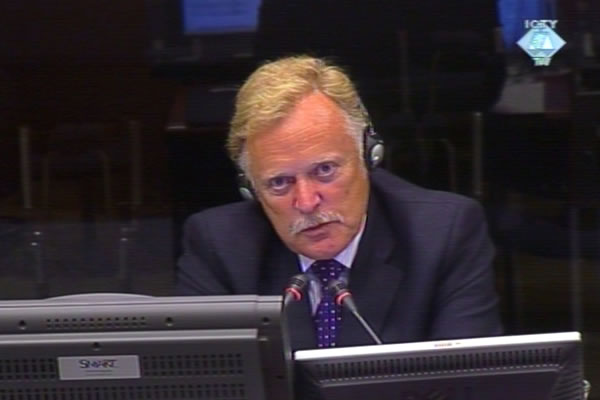Home
SARAJEVO WAS A DANGEROUS PLACE TO LIVE
The indiscriminate shelling from the VRS positions in the second half of 1992 ‘made Sarajevo a dangerous place to live’, senior UN military observer Richard Mole said in his evidence. Shells fell every single day and about 15 civilians were killed every day by snipers and shells
 Richard Mole, witness at Radovan Karadzic's trial
Richard Mole, witness at Radovan Karadzic's trial The trial of Radovan Karadzic continues with the evidence of British lieutenant colonel Richard Mole. From 16 September to 26 December 1992, Mole served as senior UN military observer in Sarajevo. The main task of the military observers was to control the use of heavy artillery and other weapons of the warring sides.
The prosecution tendered into evidence Mole’s written statement based on his previous testimony at the trial of General Stanislav Galic, former commander of the VRS Sarajevo-Romanija Corps. According to the statement, in the three months of the witness’s stay, shells fell on the city every single day. The military observers estimated that about 15 civilians were killed every day by the shells and snipers bullets in Sarajevo. Describing life in Sarajevo in the second half of 1992, the witness said that all the inhabitants – including the international military observers – were in constant fear for their lives, ‘wherever they went’. The fear that was ‘enormous and all-pervading’.
As the witness put it, the indiscriminate shelling from the VRS positions ‘made Sarajevo a dangerous place to live’. When he asked the SRK command to provide an explanation after three shelling incidents in a single day, the witness was told that ‘one set of shells was fired for each finger in the Serb [three-finger] salute’. On other occasions, the witness was told that the Serb gunners ‘were warming up their barrels’.
The Bosnian Serb strategy was to exert constant pressure on the city they held under the siege in order to implement their objectives in other places, the witness concluded.
In the first half of his cross-examination Karadzic used Otes as an example to prove that the shelling of Sarajevo was ‘legitimate’ because it was always in response to the provocations by the BH Army. Karadzic also tried to contest the ‘accuracy’ of the military observers’ reports because they were few and they couldn’t control how all the weapons were used by the warring factions.
Karadzic insisted on the witness’s statement that ‘reporters didn’t always report accurately’ the events in Sarajevo. The witness confirmed that he personally believed there was ‘a strong anti-Serb bias in the coverage of the entire conflict in the media, maybe even in a wider context too – up to some high ranking politicians’ he met and talked to.
The Trial Chamber granted Karadzic an additional half an hour to complete his cross-examination of the witness. Presiding judge O-Gon Kwon indicated that the Trial Chamber would rule by the end of the week on Karadzic’s motion to adjourn the trial for three weeks in order for him to listen to the audio recordings of the conversations of VRS commander Ratko Mladic, seized in a search of Mladic’s wife’s Belgrade apartment.
Linked Reports
- Case : Karadzic
- 2010-07-22 KARADZIC AND SOWS
- 2010-07-21 FEARS OF ‘ETHNIC HOSTAGES’ IN SARAJEVO
- 2010-07-20 KARADZIC COUNTERS VIDEOS WITH HIS OWN FOOTAGE
- 2010-08-18 WITNESS FORGOT DETAILS
- 2010-08-19 KARADZIC: SARAJEVO INVESTIGATIONS WERE ‘IMPROVISED AND SLOPPY’
- 2010-08-20 MLADIC’S DIARIES ADMITTED INTO EVIDENCE
